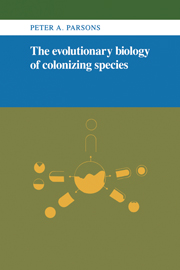Book contents
- Frontmatter
- Contents
- Preface
- 1 Introduction: Colonists and habitats
- 2 Genetics and ecology
- 3 Physical conditions, resources, and ecological phenotypes
- 4 Variability in natural populations
- 5 Genetic variability, ecological phenotypes, and stressful environments
- 6 Colonizing phenotypes and genotypes
- 7 Behavioral variability in natural populations
- 8 Habitat selection
- 9 The ecobehavioral phenotype: generalists and specialists
- 10 The ecobehavioral phenotype: biological control and domestication
- 11 Parasites and plants
- 12 Discussion and conclusions
- Appendix The study of quantitative traits
- References
- Index
2 - Genetics and ecology
Published online by Cambridge University Press: 15 September 2009
- Frontmatter
- Contents
- Preface
- 1 Introduction: Colonists and habitats
- 2 Genetics and ecology
- 3 Physical conditions, resources, and ecological phenotypes
- 4 Variability in natural populations
- 5 Genetic variability, ecological phenotypes, and stressful environments
- 6 Colonizing phenotypes and genotypes
- 7 Behavioral variability in natural populations
- 8 Habitat selection
- 9 The ecobehavioral phenotype: generalists and specialists
- 10 The ecobehavioral phenotype: biological control and domestication
- 11 Parasites and plants
- 12 Discussion and conclusions
- Appendix The study of quantitative traits
- References
- Index
Summary
The subdivision of all natural selection into r selection and K selection is convenient, because it is a fairly natural subdivision, but it is by no means the only possible one.
[MacArthur, 1972]Analyses of life histories
There are signs that the integration of genetics at the population level with ecology that is needed for a coherent evolutionary biology of populations is beginning (Jain, 1979; Price, 1980; Parsons, 1982a). Population geneticists frequently choose clear-cut genetic markers – chromosomal inversions, recessive lethals, and electrophoretic variants – in order to study population variability. Having assayed variability, a search is made for the ecological significance of the variability patterns, almost as a second-order situation. By contrast, the ecologist takes traits of obvious adaptive significance in determining the distribution and abundance of organisms; the genetic basis of the traits is not often considered. Following Jain (1979), who was mainly considering plants, analyses of adaptation should proceed with (1) comparative studies of variation of several well-chosen traits, (2) the establishment of adaptive roles of these traits, (3) the demonstration of genetic changes under varying environments, and (4) the experimental demonstration of whether the outcomes represent adequate solutions to an adaptive challenge. Until recently, points (2) to (4) were not often considered, but the situation is beginning to change in that regard. This means that inferences are often speculative, since these omissions mean that genetic aspects tend to be given little emphasis – a conclusion that applies to animals and plants alike.
- Type
- Chapter
- Information
- The Evolutionary Biology of Colonizing Species , pp. 9 - 19Publisher: Cambridge University PressPrint publication year: 1983



